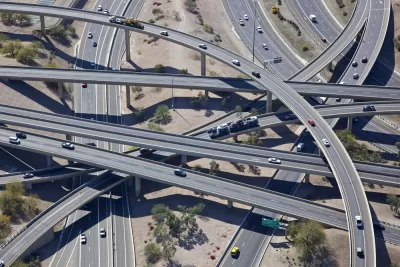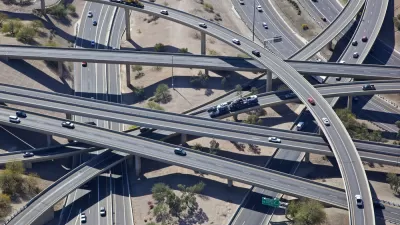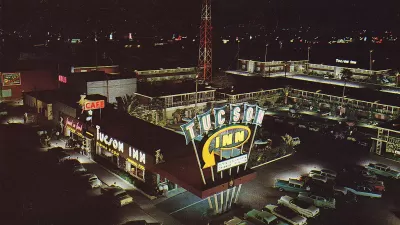A new report commemorates the 60th birthday of the interstate highway system with statistics (some politically motivated) that summarize the state of the nation's largest public works project.

"The interstate highway system hits 60 – years, not miles per hour – this week amid unprecedented travel, growing congestion and a backlog for repairs," according to an article by Bart Jansen.
The article relates statistics from a report by TRIP: A National Transportation Research Group [pdf] that analyzes data from the Federal Highway Administration. Since President Eisenhower signed the system into law on June 29, 1956, vehicle miles traveled in the system has grown from 626 billion to 3 trillion, and the number of vehicles using the system has grown from 65 million to 260 million, according to the report. The article also makes clear that the report is pushing a narrative of the interstate highways system as underfunded and deteriorating.
Alex Chrichton picked up news of the report in a separate article, noting that TRIP includes representatives from the engineering, construction, and highway industries. Chrichton's coverage focuses especially on the poor marks delivered to New York state's system of interstate highways.
FULL STORY: 31 15 3 Interstates celebrate 60 with more traffic, congestion

Alabama: Trump Terminates Settlements for Black Communities Harmed By Raw Sewage
Trump deemed the landmark civil rights agreement “illegal DEI and environmental justice policy.”

Study: Maui’s Plan to Convert Vacation Rentals to Long-Term Housing Could Cause Nearly $1 Billion Economic Loss
The plan would reduce visitor accommodation by 25% resulting in 1,900 jobs lost.

Why Should We Subsidize Public Transportation?
Many public transit agencies face financial stress due to rising costs, declining fare revenue, and declining subsidies. Transit advocates must provide a strong business case for increasing public transit funding.

Paris Bike Boom Leads to Steep Drop in Air Pollution
The French city’s air quality has improved dramatically in the past 20 years, coinciding with a growth in cycling.

Why Housing Costs More to Build in California Than in Texas
Hard costs like labor and materials combined with ‘soft’ costs such as permitting make building in the San Francisco Bay Area almost three times as costly as in Texas cities.

San Diego County Sees a Rise in Urban Coyotes
San Diego County experiences a rise in urban coyotes, as sightings become prevalent throughout its urban neighbourhoods and surrounding areas.
Urban Design for Planners 1: Software Tools
This six-course series explores essential urban design concepts using open source software and equips planners with the tools they need to participate fully in the urban design process.
Planning for Universal Design
Learn the tools for implementing Universal Design in planning regulations.
Smith Gee Studio
Alamo Area Metropolitan Planning Organization
City of Santa Clarita
Institute for Housing and Urban Development Studies (IHS)
City of Grandview
Harvard GSD Executive Education
Toledo-Lucas County Plan Commissions
Salt Lake City
NYU Wagner Graduate School of Public Service





























